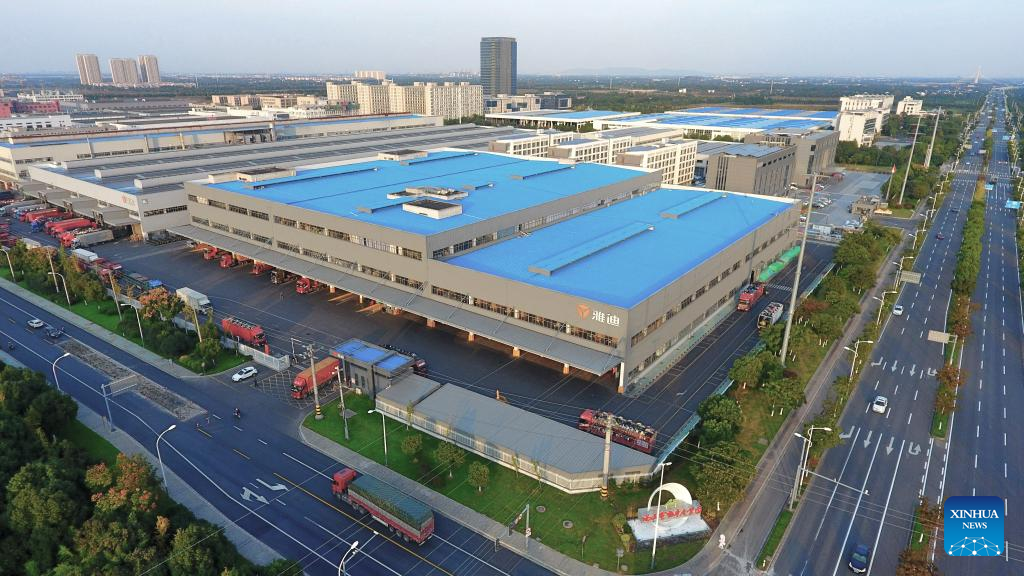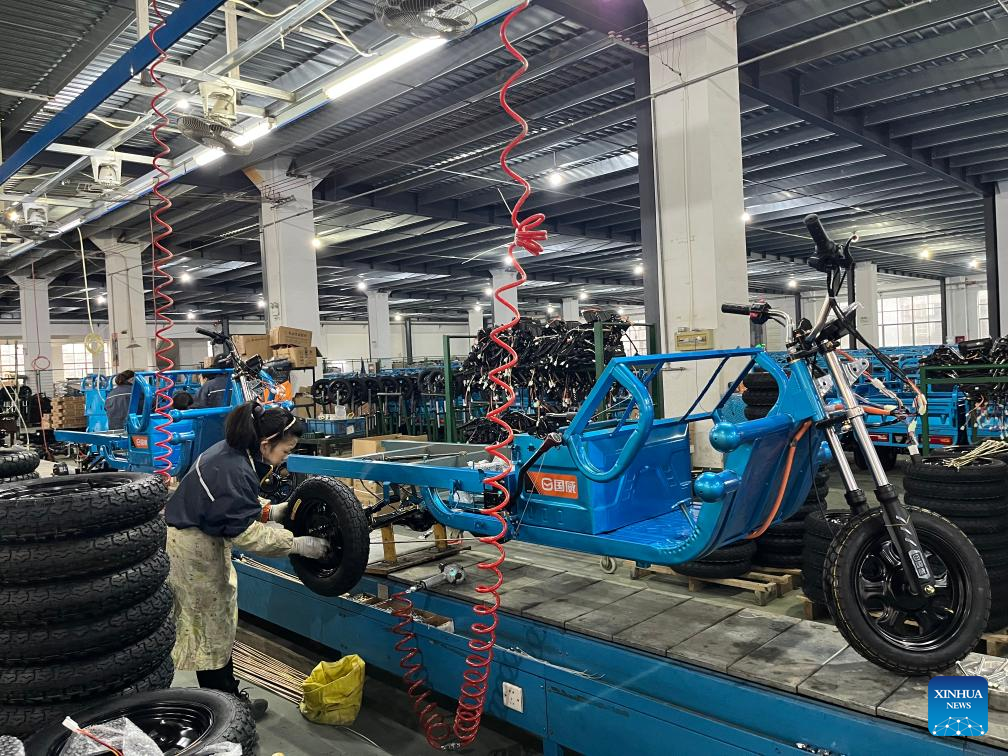
This undated file photo shows an aerial view of an electric vehicle industrial park in Xishan district of Wuxi City, east China's Jiangsu Province. (Xinhua)
by He Leijing
NANJING, March 22 (Xinhua) -- Imagine a vehicle that allows for effortless driving and has space for both passengers and cargo, is easily affordable and does not require fuel. Sounds enticing, doesn't it? But it's not imaginary -- What I'm describing is a Chinese-made electric tricycle.
Not long ago, a U.S. resident ventured out on one such a tricycle, eliciting curiosity and admiration from neighbors. The electric tricycle has a sleek design, practical performance and an unusual warning sound: "Please pay attention, I'm backing up!" Video clips of the vehicle have garnered significant attention on social media platforms overseas, with some netizens even hailing it their "dream vehicle."
Yet as the buzz grows, I find myself pondering why this vehicle, which has long been popular across China, has only recently made waves overseas. If you were to journey into China's rural areas, you would find that these vehicles are almost ubiquitous.
The electric tricycle that has wowed U.S. residents is made by Jiangsu Guowei Motorcycle Co., Ltd., which is located in the Xishan district of Wuxi City in east China's Jiangsu Province. And it is priced at a modest 600 U.S. dollars.
Stepping into a Guowei workshop, I encountered a bustling scene of production and assembly, with skilled workers meticulously assembling electric tricycles in minutes. Rows of pristine blue tricycles stood ready to be shipped to overseas markets, including the United States. My visit gave me a sense of the company's vibrancy.
After a candid conversation with Ni Xiaofeng, Guowei's general manager, I learned that the company's overseas orders have surged this year, and that the electric tricycle's popularity abroad was no stroke of luck.
Ni said that with nearly two decades of experience in exports, his company is well-prepared to embrace overseas markets, and that the increasing global emphasis on low-carbon transportation has presented a golden opportunity to sell electric vehicles with decent driving speeds.
The Guowei R&D team conducts extensive research on target overseas markets, studying regulations, road conditions and travel habits to tailor the company's three-wheelers to local needs. Moves such as the adoption of anti-rust technology and the improvement of battery range have resulted in the creation of over 100 product varieties.
Delving deeper, I realized that Guowei is not the only enterprise blazing a trail in its export endeavors. Xishan has earned a reputation as the "hometown of Chinese electric vehicles," producing one out of every three e-bikes globally -- three-wheeled or not.
Xishan is the largest R&D and manufacturing base for electric vehicles in China, with an annual output of over 15 million units. Its industry scale, competitive pricing and complete industrial chain have drawn global attention to its products.
Electric vehicle companies in Xishan often venture abroad in groups, frequently showcasing their products at overseas exhibitions to bolster their brand influence. And with their products now available in over 140 countries and regions, many have established factories and sales networks overseas, realizing localized production, sales and after-sales services to cement their status as global players.
The international success of Chinese-produced electric tricycles are representative of the current global appeal of made-in-China products. As the consumption market of the world's second-largest economy is upgraded and diversified, domestic brands have gradually shed their former image of being cheap and low-end. But their continued, relative cost-effectiveness is still favored by overseas markets amid slow global economic recovery and weak international trade.
Affordability, quality and advanced technology are among the features overseas consumers have highlighted in their evaluations of Chinese goods. Electric tricycles, for example, are highly adaptable and can be used almost anywhere -- from the narrow streets of European cities to vast farms in the countryside.
Alongside China's established export categories like smartphones and clothing, Chinese-produced tea drinks, cosmetics and specialty agricultural products are now highly sought-after by overseas consumers on the cross-border e-commerce platforms of domestic enterprises.
Cat owners overseas, for example, are increasingly eager to purchase Chinese-made smart litter boxes and automatic pet feeding machines. And handmade bags and shampoos produced with traditional Chinese craftsmanship are also in high demand globally.
The rise of cross-border e-commerce has allowed international consumers to access oceans of quality products from all over China with ease. Data show that China's cross-border e-commerce imports and exports totaled 2.38 trillion yuan (330.6 billion U.S. dollars) in 2023, a year-on-year increase of 15.6 percent.
And with its sales networks now covering more than 220 countries and regions, cross-border e-commerce has become an important driving force for China's foreign trade growth.
Aiming to transform more products from fads to goods with enduring popularity, Chinese manufacturing is making strides in product innovation, services enhancement and the development of stable industrial and supply chains, achieving improvements in both quality and brand recognition.
By leveraging new sales channels and marketing strategies, China is solidifying its reputation as a global manufacturing powerhouse. And as we look to the future, one thing is certain: More quality, innovative products from China will grace the global stage, enriching the lives of consumers around the world. ■

A worker assembles electric tricycles at a workshop of Jiangsu Guowei Motorcycle Co., Ltd. in Xishan district of Wuxi City, east China's Jiangsu Province, Feb. 15, 2024. (Xinhua)



